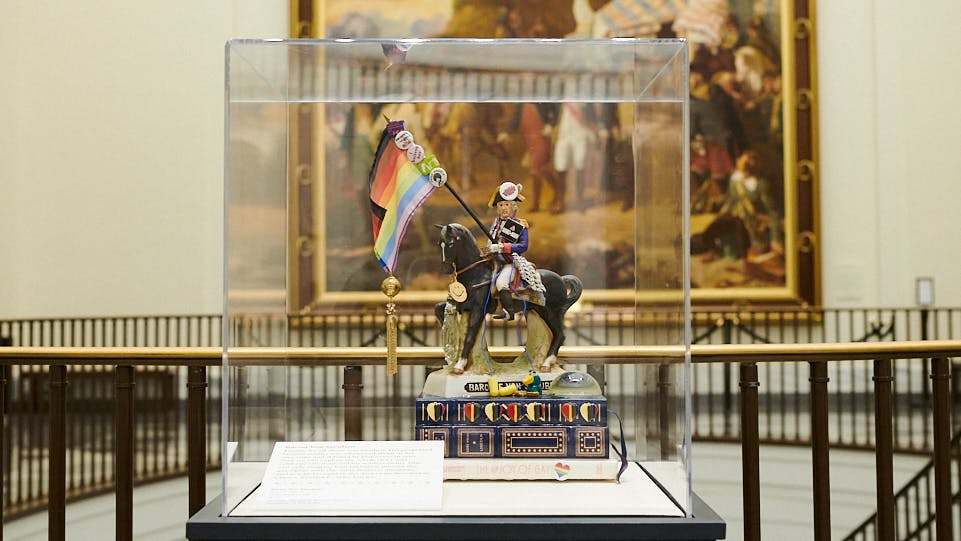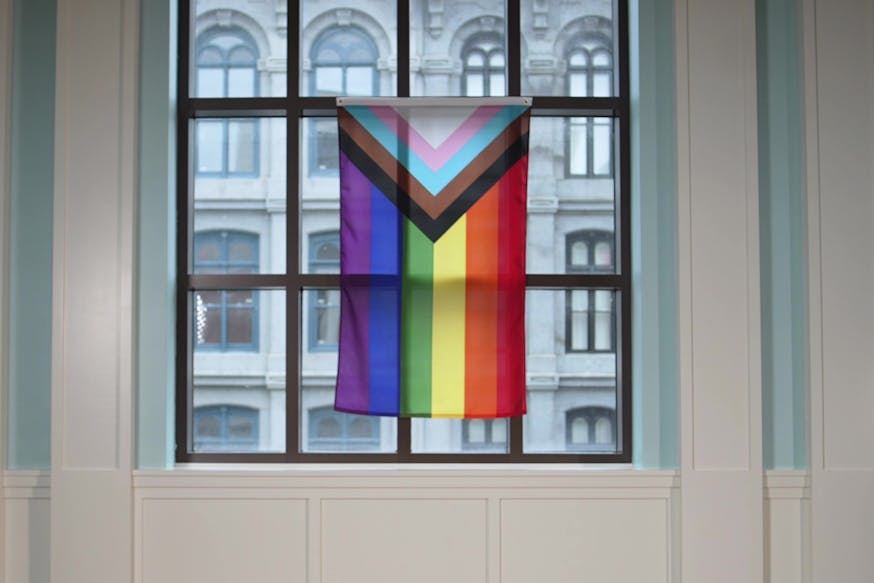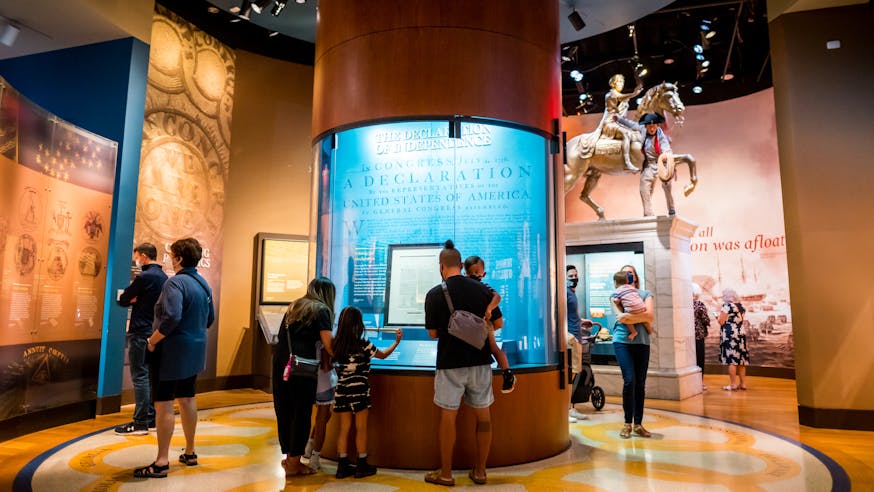Whiskey Rebellion
Q&A with "Whiskey Rebellion" Artist John Y. Wind
June 2024
Throughout June 2024, the Museum is showcasing "Whiskey Rebellion," an installation of sculptures by Philadelphia artist John Y. Wind in the second-floor Oneida Indian Nation Atrium. Wind’s work transforms hand-painted, ceramic decanters of key figures from the American Revolution that were produced by the Jim Beam Distilling Company and their competitors from the 1960s-70s to circumvent a new federal whiskey tax and tap into Bicentennial fever. His recontextualized works explore issues of masculinity, heroism, diversity, and commemoration through a 21st-century lens.
The Museum spoke with Wind about his personal journey as an Israeli-American, the inspiration and meaning he injects into his works, and the significance of "Whiskey Rebellion" being displayed at the Museum of the American Revolution.

MoAR: You were born in Israel and immigrated to the United States at a young age. What was it like for you growing up as an immigrant in America, and what were your first understandings of America and its founding story? How has that understanding grown and evolved over time?
JYW: My parents and I arrived from Israel in 1963. I was two years old, and they were eager for me to fit in, so we spoke only English at home and very soon changed my name from Yaron to Johnny. (John F.) Kennedy was assassinated that same year, and our family took part in the national grieving, even buying our first television to watch the news unfold.
In 1976 we became U.S. citizens and part of the country’s Bicentennial story. I remember my parents studying their American history as I coached them with my grade school knowledge. We all had a great feeling of pride and belonging the day we were naturalized. But at the same time, we were still foreigners, with ‘exotic’ accents, ethnic food, weekly calls and summer visits to my grandparents in Israel, and annual attendance at the Israel Independence Day Parade on Independence Mall (just blocks from the Museum).
All of this led to an isolating duality — sometimes outside, sometimes in. As I began to discover and process my sexuality, another layer of separation emerged. Dreaming of becoming an artist was oddly another secret I felt the need to keep, as it was not the planned script. So suffice to say, through my high school years I felt othered and closeted most of the time.

MoAR: How did art become your life’s path? How is your personal story reflected in your art, particularly in “Whiskey Rebellion?”
JYW: Art was always around me growing up. My mother was an artist. My parents collected, and most of our free time revolved around looking at art. I took after-school and summer classes at PAFA and PCA (now UArts). In my senior year of high school, I finally got into the art room and "found my people." I knew then that this was what I wanted to do and be, though how to make it happen was the question.
While at the University of Pennsylvania as a creative writing major, I won a two-year scholarship to the Slade School of Fine Art in London. This was the real turning point in my journey. I showed up on day one with the freedom to be myself on every level — as an artist, as a gay man, and as an Israeli-American expat. The art I made was autobiographical, whether paintings based on moody photos I took in nightclubs or brooches made from found objects purchased at Brick Lane flea market across the street from where I was living. The jewelry almost accidentally became my career, and over the years I’ve had a bit of a tug of war between making jewelry and fine art.
But I’ve always been interested in how objects represent us and can create a portrait. And I’ve come to embrace employing the materials and language of jewelry in my sculpture. This is how I approached the figures in "Whiskey Rebellion," including charms, pins, gadgets, books and other objects that either represent the historical figures or my own contemporary take on them. It is a way of bringing myself into the narrative, and of making history relevant and relatable for both me and the viewer. We are told that the First Pennsylvania Regiment, for example, were a group of fearless and able men on the battlefield; but the way I see it, they were also just young adults interested in drinking beer, playing with their dogs, and listening to music — which I represent by putting them on pedestals made from audio speakers and stacks of Madonna and Grace Jones CDs, embellished with bottle caps of some favorite Pennsylvania beers (Yards and Victory), and wearing necklaces assembled from vintage brass dog tax licenses.
MoAR: In “Whiskey Rebellion,” you include the traditional idea of “Founding Fathers,” with the inclusion of George Washington and Thomas Jefferson, but you also include foreign “heroes” of the Revolutionary War, like Comte de Rochambeau, Thaddeus Kosciusko, and Baron von Steuben, as well as representation of the common soldiers. What does inclusion of the different groups say separately and as a collective?
JYW: The diversity is intentional, and I recently added two “Founding Mothers” as well — Betsy Ross and Molly Pitcher. America is a tossed salad, so I wanted this series to represent a broad cross-section of the players in our founding story. It’s worth noting that I was limited to historical figures deemed commercially viable by the marketing people at Jim Beam Whiskey and their competitors back in the 1960’s and '70’s — I tried hard to find a Crispus Attucks decanter, for example, but to no avail…

MoAR: The messages of the artistic interventions represent an intersectional range of social and political issues. Did you choose specific historical figures to display certain messages more strongly? From your perspective, what’s the balance of the messages on the individual decanters vs. the message of the collective collection?
JYW: I started each piece by focusing on the individual and responding in their voice, like Baron von Steuben holding a Pride flag and standing atop a benchmark book of gay liberation, and Molly Pitcher wearing a ‘fight like a girl’ pin along with other feminist slogans. But then I layered on messages and materials reflecting my own values and interests, like the environment or gun control, projecting them on the characters as both provocation and wishful thinking… For some figures I took more artistic liberties than others, for example giving the Baylor Boys an affirming LGBTQ+ backstory.
Then, as I was accessorizing the figures (feeling equal parts fashion designer and boy playing with dolls), it occurred to me that these message clusters would be really fun and empowering to actually wear. So in a life-imitates-art moment, I’ve created a collection of one-of-a-kind collage brooches available for sale in the Museum Shop. These assemblages mix all kinds of message pins with vintage brooches and sparkling jewelry components. They allow the viewer to join in and wear the messages that they relate to most. And they bring my two worlds together in a really gratifying way.

MoAR: For you personally, for you as an artist, and for the “Whiskey Rebellion” collection, what is the significance of these being displayed at the Museum of the American Revolution?
JYW: It is hugely significant on all counts! First, I am honored that the Museum’s President & CEO, Dr. R. Scott Stephenson, and his colleagues appreciate my art and want to share it. This is my first solo museum exhibition, so I feel accomplished and grateful. As a lifelong Philadelphian, exhibiting in my hometown adds an extra layer of meaning and pride. Then the fact that the Museum is open to telling my story, with its queer subtext and contemporary take on an historical narrative, is brave and bold. I believe that it is also enlightened, as it sends a message that the Museum of the American Revolution is for everyone, that diverse voices are shared and heard, and that the American experiment continues to evolve and expand its relevance to all.
"Whiskey Rebellion" is on view at the Museum in the second-floor Oneida Nation Atrium from June 1-30, 2024.
Learn More

John Y. Wind Artist Talks & Philadelphia Freedom Band Performance
June 22, 2024, from 10 a.m. - 3 p.m.
Pride Month at the Museum

